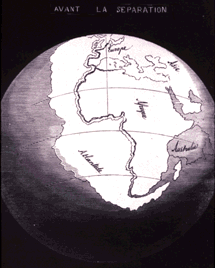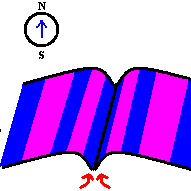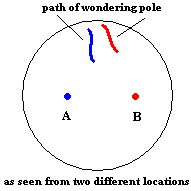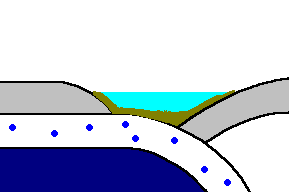
This is a major theory that is relatively new (compared to other
revolutionary theories in science). It helped explain earthquakes,
volcanoes, mountain building, and differences between the oceanic and continental
crust (and how they got the way they are).
Have you ever looked at a globe and wondered about the "fit" between the east coast of the Americas and the west coast of Europe and Africa? Most kid have. Did you go the next step and wonder if they were indeed connected?

In 1858, geographer Antonio Snider-Pellegrini thought so and made this picture: (in fact, this notion was first suggested as early as 1596 by the Dutch map maker Abraham Ortelius)

from the USGS
Click here to view the major plates on the earth.
I do not have details about plate tectonics in the handouts. This is not because plate tectonics is not important - it is the most important topic in this class. It is because there is a much better source of information. Please make sure you read the online link listed below.
We will investigate this theory using "The Dynamic Earth" ... an excellent on-line paper on plate tectonics and in-class students will be viewing a video tape on the early history of the theory called A Science Odyssey - Origins.
Here is a brief outline to help you know what to study:
People who developed the theory:
 (animation)
(animation)
 (animation)
(animation)
Where (on the earth) can you find these major plate boundaries?

Convergent Continental - Oceanic Plate Boundary (animation)

Convergent Oceanic - Oceanic Plate Boundary (animation)

Convergent Continental - Continental Boundary (animation)
Click here
to see a cool picture of the Himalayas.
Click here
to see a cool picture of Mount Everest (world's highest mountain at 29,028
feet),
both images from http://www.geocities.com/Yosemite/Trails/3536/everest.html
Can you provide classic examples of each of the following?
The
Marianas Trench (in
the Pacific)
The Himalayan Mountains
The Cascade Mountains (Pacific Northwest in the state of Washington)
All along the boundary of the Pacific Ocean
The mid-Atlantic ridge
The San Andres Fault
African Rift Valley
The Red Sea
The Andes Mountains (South America)
Which is the largest oceanic plate? largest continental plate?
Is the North American plate all continental crust? all oceanic crust? or a combination of both?
What is a "hot spot" and where are some major ones on the earth? Click here to read an alternate idea about hot spots.
In a collision of plates, why is oceanic crust forced under continental crust? Think about what will happen if oceanic crust collides with oceanic crust ... or continental crust collides with continental crust.
How do you make an "arc" of islands (such as the Aleutian Islands or Japan)?
How fast do plates move?
What drives plate motion? What is the "power source"? Will it last forever?
Where are the highest and lowest places on the earth (and how did they get that way)?
What is an active boundary? a passive boundary? (and where can you find the closest ones?)
When did land first appear on the earth?
Most of the continents formed between 4.2 billion and 2.5 billion years ago (the beginning of plate tectonics). Before that, the earth was most likely a shallow sea (water world). Life got started in those early seas - very simple and single celled.
What is a craton (or shield)?
Give two ways continental crust may be added to the margin of a continent? Hint: One adds mass slowly (and was covered in unit 1) and the other quickly.
Why is the % of land on the earth (29%) been fairly constant for such a long time? That is, there are two competing processes going on at the same time ... one that makes continental crust (already discussed) and one that removes it (also already discussed). Both of these processes are pretty well balanced.
Why is the average age of oceanic crust only about 55 million years (the oldest parts are about 180 million years old), and the average age of the present day continental crust is about 2.3 billion years, (the oldest known rocks (other than meteorites) dating back 4 billion years)? In other words, why is the oceanic crust young and continental crust MUCH older?
Is there evidence of plate tectonics on Venus (which is just about the same size as earth)?
What was Pangaea? When did it happen?

from the USGS
Check out this site - it is VERY GOOD ... please read it all!
Page with animations, history, and mechanisms - click here
A "mini lesson" from volcano world - click here
Some neat graphics - click here
Some images from space - click here
ŠJim Mihal 2004, 2006 - all rights reserved